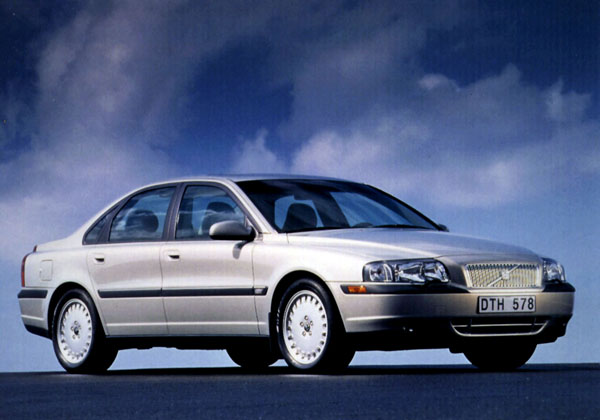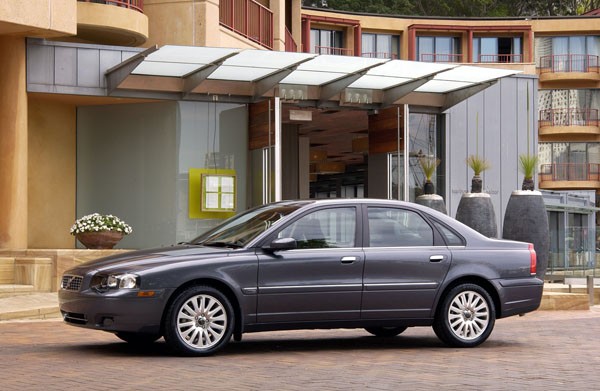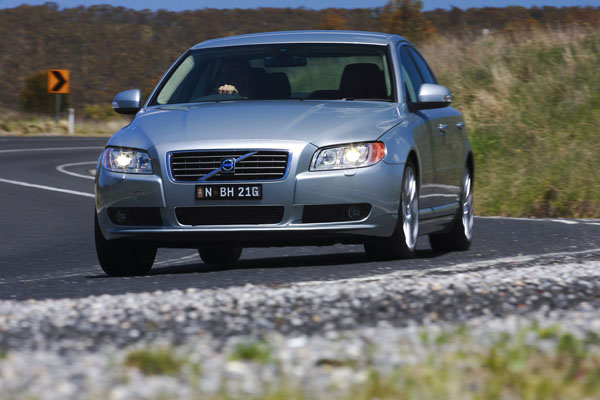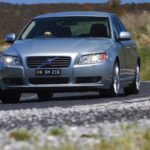The Volvo S80 is the model that changed the image of the Swedish car company back in the dying years of the 20th century. Once seen as the company that built safe and square, but unexciting machines, Volvo is nowadays regarded as a style leader and it was the big S80 sedan that led the way.
The Volvo S80 has attractive looks that are very much in the ‘simple but effective’ Swedish manner, particularly in the cabin. The clever thing is that the curvaceous look of the new generation Volvos doesn’t interfere with the functionality of the S80, or indeed with the rest of the Volvo range. Comfortable, spacious interiors are still an integral part of company’s design.
However, the S80 didn’t do particularly well in Australia. Buyers looking for large cars either go for Commodore or Falcon if their budgets are tight, or one of the upmarket German machines.
There’s plenty of variety in this big Volvo, like the other car choices we’ve just mentioned its offered with six-cylinder or V8 engines, as well as with a turbo-diesel option. Diesels aren’t sold in the aforementioned Holdens and Fords, but are increasingly popular in German cars. Volvo even imports some all-wheel-drive variants of the big S80. These aren’t aimed at off-road work but at the icy roads of its home market. Australia skiers therefore have another option, than an SUV.
Ride comfort is excellent and the Volvo S80 does an excellent job of cocooning its occupants from the outside world. Handling is safe and predictable and the cars are easy to drive. Though they have a semi-sporty feel on the road a smooth ride has been given top priority over road holding.
It goes without saying that the Volvo S80 carries a full range of safety features. These include a full array of airbags, front seats with headrests and seat-backs which collapse in a controlled manner during a rear-end crash to minimise the dangers of whiplash injuries. All five seating positions come with pyrotechnic safety-belt pretensioners.
On introduction to Australia in 1998, the Volvo S80 was offered with a 2.9-litre six-cylinder engine and a hot, twin-turbo, 2.8-litre six. The latter, tagged Volvo S80 T6, gives huge reserves of overtaking safety, thanks to strong acceleration and minimal turbo lag.
Earlier versions of the Volvo used front-wheel drive and come only with a four-speed automatic transmission. It has manual override in the T6 version to give the driver extra control. This was increased to a five-speed unit in the standard six during 2002, then to six forward ratios with the all-new model in 2007.
Given Australian drivers love of grunty cars, the standard S80 model was less popular than the T6 and was pulled off our market midway through 2003. The Volvo S80 T6 continued to be a player on the new-car scene.
The Volvo S80 went through a flat time in the Australian market and was discontinued late in 2005 as the car became outdated and the replacement wasn’t yet in sight.
January 2007 saw the return of the model when an all-new Volvo S80 was launched. This new-generation machine came with sculpted lines that made a positive styling statement. The interior was particularly impressive and many described at is being almost be a Swedish lounge room in its concept.
A 3.2-litre straight-six was introduced. That was during a period of rapidly rising fuel prices so Volvo Australia added a 2.4-litre turbo-diesel to the range at the same time. This engine was a clever five-cylinder unit. A compact V8 engine was also introduced during that 2007 revitalisation. With 232 kW, the 4.4-litre Volvo V8 could make the zero to 100 km/h run in just 6.5 seconds.
All the new-generation Volvo S80s imported to Australia had a modern six-speed automatic transmission with manual overrides.
Volvo S80 is only sold as a sedan. The Volvo V70 station wagon is based on the same platform as the S80, but oddly it is slightly smaller than the sedan. You may also care to consider variants of the Volvo V70, the all-wheel-drive Cross Country and the V70 XC.
These modern Volvos are complex machines with a lot of electronic components so are best left to professional mechanics for anything other than very basic servicing and repair items. The underbonnet area is pretty crowded so even if you do some of your own work it can be a tricky. Probably you’re best to leave it to the experts.
Insurance companies like Volvos, not only because of the protection they offer occupants in crashes, but also because a considerable amount of design work has gone into making them relatively easy to repair after minor prangs.
Some companies may load the premiums on the turbocharged engines, though that’s much less common than in the past.
WHAT TO LOOK FOR
Built to a high quality, the Volvo S80 is standing up well to the tests of time, but the older ones are now well into their second decade so may be getting near their use-by date.
Check for an engine that’s reluctant to start or doesn’t idle properly.
Listen for unwarranted noises from a turbo engine, particularly when you work it hard and during fast gearchanges.
Look for smoke from the exhaust at the same time when the engine has been idling for a while then accelerated hard.
The Volvo S80 is generally fine on rough roads, but listen for noises from the suspension that may indicate wear.
Make sure all gearchanges from the automatic smooth and are all but impossible to feel unless at low to moderate throttle openings. Noisy changes from Drive to Reverse and vice versa are often the first signs of trouble.
Watch out for a performance model that has been driven hard. Uneven wear to the front tyres if often a good indicator of harsh driving. As is a lot of brake dust on the inside of the front wheels. Smart sellers will have cleaned the dust off the outside of the wheels, but sometimes forget to do the out of sight areas.
CAR BUYING TIP
If you want to do your own repairs on any car it makes a lot of sense to have a workshop manual at your elbow at all times.














